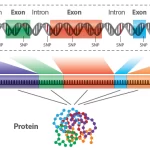
Challenges and Future Directions of Single-Cell Sequencing
January 4, 2024Advancements in genomics have transformed our understanding of the intricacies of cellular diversity and function. Single-cell sequencing, a revolutionary technique, has played a pivotal role in unraveling the complexity inherent in heterogeneous cell populations. However, as with any cutting-edge technology, single-cell sequencing comes with its own set of challenges. This essay explores the current hurdles and potential future directions of single-cell sequencing.
Challenges:
1. Technical Variability:
One of the significant challenges in single-cell sequencing is the inherent technical variability introduced during the isolation and amplification steps. The low starting material amplification can result in biases, affecting the accuracy of downstream analyses. Addressing this challenge is crucial for obtaining reliable and reproducible single-cell data.
2. Data Integration and Analysis:
Single-cell sequencing generates vast amounts of data, and the integration and analysis of this information present substantial challenges. The heterogeneity within and between cell types requires sophisticated computational approaches for meaningful interpretation. Developing robust bioinformatics tools to handle the complexity of single-cell datasets is an ongoing challenge.
3. Cost and Throughput:
The cost associated with single-cell sequencing remains a hurdle for widespread adoption. High-throughput methods are essential for studying complex tissues or large patient cohorts comprehensively. Striking a balance between cost-effectiveness and increased throughput is a challenge that the field is actively addressing.
4. Spatial Transcriptomics:
Understanding the spatial organization of cells within tissues is critical for unraveling their functions. Current single-cell sequencing technologies often lack spatial resolution, making it challenging to decipher cellular interactions within their native microenvironments. Integrating spatial transcriptomics into single-cell approaches is a frontier that researchers are keenly exploring.
5. Rare Cell Detection:
Detecting and analyzing rare cell populations is challenging due to the limited sensitivity of current single-cell technologies. For applications such as circulating tumor cell analysis or studying rare immune cell subsets, improving the sensitivity of single-cell sequencing methods is imperative.
Future Directions:
1. Technology Refinement:
Advancements in microfluidics and nanotechnology hold promise for refining single-cell sequencing technologies. Improved cell isolation methods, reduced technical variability, and enhanced sensitivity will contribute to more accurate and reliable results.
2. Multi-omics Integration:
Integrating different omics layers, such as genomics, transcriptomics, and epigenomics, at the single-cell level will provide a comprehensive view of cellular states. Developing methodologies for multi-omics integration is a future direction that can uncover deeper insights into cellular functions.
3. Spatial Transcriptomics Advancements:
Incorporating spatial information into single-cell sequencing approaches is an exciting avenue for future research. Technologies that capture both the transcriptomic and spatial context of individual cells within tissues will provide a holistic understanding of cellular interactions.
4. Standardization and Benchmarking:
The development of standardized protocols and benchmarks for single-cell sequencing is essential for ensuring data reproducibility and comparability across studies. Efforts to establish community standards and guidelines will contribute to the robustness of single-cell technologies.
5. Single-Cell Therapeutics:
The insights gained from single-cell sequencing have profound implications for personalized medicine. Future directions include leveraging single-cell data to develop targeted therapeutic interventions, especially in areas like cancer treatment, where cellular heterogeneity plays a crucial role in treatment response.
In conclusion, while single-cell sequencing has revolutionized our understanding of cellular diversity, it is not without its challenges. Addressing technical limitations, improving data analysis tools, and exploring new frontiers such as spatial transcriptomics are crucial for advancing the field. The future of single-cell sequencing holds the promise of deeper insights into cellular biology, disease mechanisms, and the development of targeted therapeutic strategies. As researchers continue to unravel the complexities of the cellular world, single-cell sequencing will undoubtedly remain at the forefront of genomics research.
















